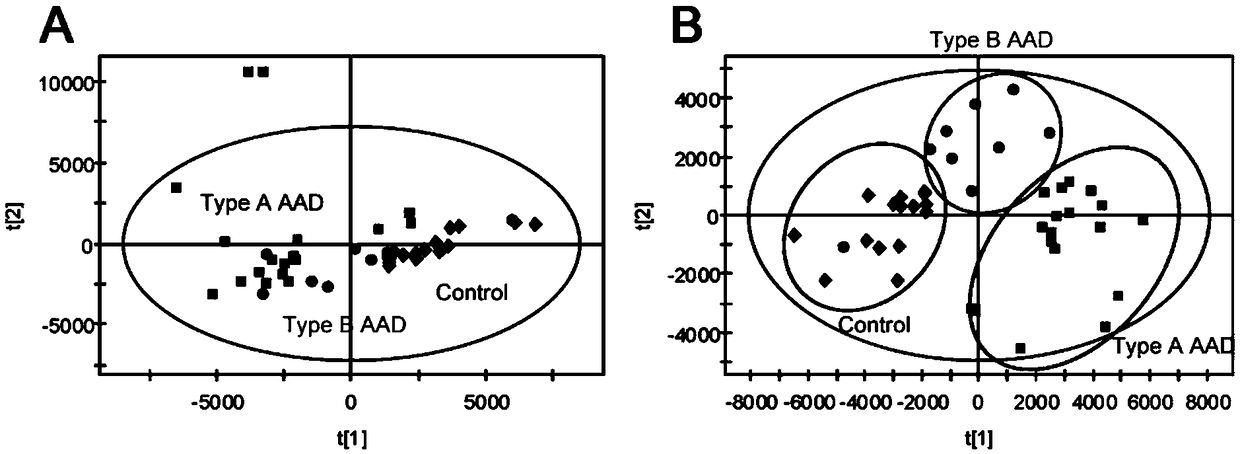Method for establishing diagnostic criterion of acute aortic dissection
A technique for the diagnosis of aortic dissection, a standard, used in the medical field
- Summary
- Abstract
- Description
- Claims
- Application Information
AI Technical Summary
Problems solved by technology
Method used
Image
Examples
Embodiment 1
[0048] Inclusion and Exclusion Criteria of Example 1 Subject Sample
[0049] The inclusion criteria for patients with acute aortic dissection are as follows: 1) The patient has acute onset within 72 hours, and the symptoms of chest pain or back pain last for more than 5 minutes; 2) Acute aortic dissection has been confirmed by CTA imaging and graded according to the Stanford grading system; 3) This acute aortic dissection is the first episode; patients must meet all the above conditions at the same time before they can be enrolled.
[0050] The exclusion criteria for patients with acute aortic dissection are as follows: 1) patients with hereditary connective tissue diseases such as Marfan syndrome, Ehlers-Danlos syndrome, and Loeys-Dietz syndrome, or patients with related family genetic history; Patients with vascular-related diseases or patients with a history of vascular interventional surgery; 3) patients with continuous hemodialysis; patients who meet any of the above crit...
Embodiment 2
[0058] Example 2 blood sample collection and processing
[0059] 2.1 Blood sample collection and storage
[0060] All blood samples were collected on an empty stomach in the morning, collected with BD SST serum separation tubes, blood clots were removed, centrifuged at 1000g at 4°C for 10 minutes, the upper serum was collected, aliquoted into 200 μL PCR tubes, labeled, and stored at -80°C.
[0061] 2.2 Sample preprocessing
[0062] Serum was thawed at 4°C, and 20 μL of serum was put into a centrifuge tube, and 380 μL of 67% acetonitrile organic precipitant (methanol / acetonitrile=1:2, v:v) (containing 5 μM internal standard L-chlorophenylalanine) was added, and vortexed 30s, keep at room temperature for 5min to precipitate protein, centrifuge at 13000rpm at room temperature for 15min, take 120μL supernatant for UPLC-MS analysis. An equal volume of solution was taken from each sample and mixed to prepare a quality control sample (QC) for evaluating the stability of the experim...
Embodiment 3
[0067] Embodiment 3 data processing and multidimensional statistical analysis
[0068] 3.1 With the help of XCMSOnline (https: / / xcmsonline.scripps.edu / ) to complete the peak extraction, correction and Integrate to obtain a multivariate data matrix of sample information, ion information (retention time and mass / nuclear ratio m / z), and ion abundance. The corrected 80% rule was used to remove missing values. The intensity of each ion is calculated by normalizing the number of ions vs. the total number of ions across the chromatogram. Finally, the normalized data was imported into the SIMCA-P V11.0 (Umetrics, Sweden) software, and after centralization and standardization, PCA and PLS-DA multidimensional statistical analysis were performed, and the variable weights of different ions were calculated based on the PLS-DA statistical model Value (variableimportanceintheprojection, VIP), screen out VIP>1.5 ions. Preliminary characterization based on the existing metabolomics database...
PUM
 Login to View More
Login to View More Abstract
Description
Claims
Application Information
 Login to View More
Login to View More - R&D
- Intellectual Property
- Life Sciences
- Materials
- Tech Scout
- Unparalleled Data Quality
- Higher Quality Content
- 60% Fewer Hallucinations
Browse by: Latest US Patents, China's latest patents, Technical Efficacy Thesaurus, Application Domain, Technology Topic, Popular Technical Reports.
© 2025 PatSnap. All rights reserved.Legal|Privacy policy|Modern Slavery Act Transparency Statement|Sitemap|About US| Contact US: help@patsnap.com



